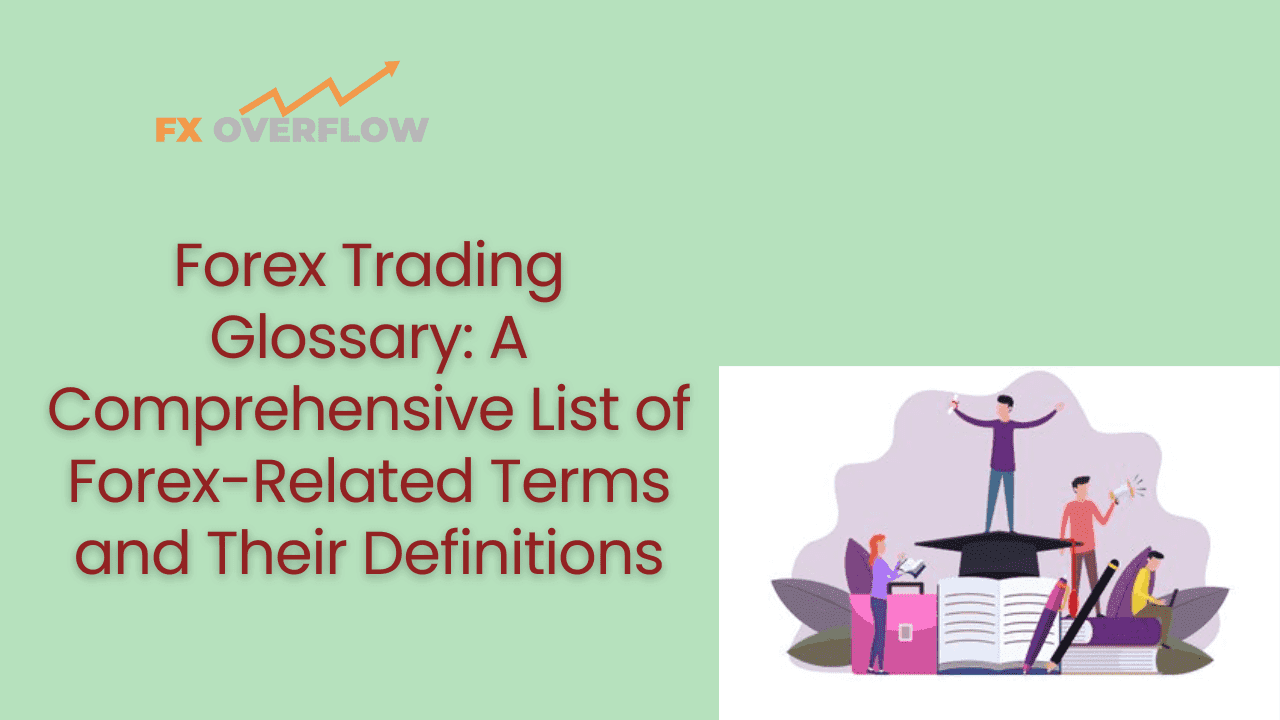Forex Trading Glossary: A Comprehensive List of Forex-Related Terms and Their Definitions
If you're venturing into the world of forex trading, you've probably encountered a barrage of unfamiliar terms and jargon that can be overwhelming for beginners. Fear not! In this comprehensive guide, we'll provide you with a complete glossary of forex-related terms and their definitions. By the end of this article, you'll be well-equipped with the knowledge needed to navigate the forex market with confidence.

Table of Contents
1. Introduction to Forex Trading
2. Understanding Currency Pairs
3. Major Currency Pairs
4. Minor Currency Pairs
5. Exotic Currency Pairs
6. Bid Price and Ask Price
7. Pip: The Smallest Price Movement
8. Leverage and Margin
9. Lots and Position Sizing
10. Long and Short Positions
11. Stop-Loss and Take-Profit Orders
12. Market Order and Pending Order
13. Technical Analysis
14. Fundamental Analysis
15. Common Forex Chart Patterns
1. Introduction to Forex Trading
The foreign exchange market, also known as forex, is the largest and most liquid financial market globally, where currencies are bought and sold. It operates 24/5, allowing traders to participate from different time zones worldwide.
2. Understanding Currency Pairs
In forex trading, currencies are always quoted in pairs, such as EUR/USD or GBP/JPY. The first currency is the base currency, while the second one is the quote currency. Understanding currency pairs is fundamental as they represent the value of one currency relative to another.
3. Major Currency Pairs
Major pairs involve the most traded currencies globally, including EUR/USD, USD/JPY, GBP/USD, and USD/CHF. These pairs are highly liquid and have tight spreads.
4. Minor Currency Pairs
Minor pairs, also known as cross currency pairs, exclude the US dollar and involve other major currencies like EUR/GBP or GBP/JPY.
5. Exotic Currency Pairs
Exotic pairs involve one major currency and one currency from an emerging or smaller economy. Examples include USD/TRY (US Dollar/Turkish Lira) or USD/ZAR (US Dollar/South African Rand).
6. Bid Price and Ask Price
The bid price is the highest price a buyer is willing to pay, while the ask price is the lowest price a seller is willing to accept. The difference between the bid and ask prices is called the spread.
7. Pip: The Smallest Price Movement
A pip is the smallest unit of price movement in forex trading, typically the fourth decimal place in most currency pairs. It represents the change in value between two currencies.
8. Leverage and Margin
Leverage allows traders to control larger positions with a smaller amount of capital. However, it magnifies both profits and losses. Margin is the collateral required to open and maintain a leveraged position.
9. Lots and Position Sizing
A lot is the standard unit size in forex trading. Traders choose lot sizes to determine the volume of their trades. Proper position sizing is crucial for managing risk.
10. Long and Short Positions
Going long means buying a currency pair with the expectation that its value will increase. Going short means selling a currency pair, expecting its value to decrease.
11. Stop-Loss and Take-Profit Orders
A stop-loss order is a risk management tool that automatically closes a trade when the market reaches a specified price. A take-profit order closes a trade at a predetermined profit level.
12. Market Order and Pending Order
A market order is executed instantly at the current market price. A pending order instructs the platform to execute a trade only when the market reaches a specific price.
13. Technical Analysis
Technical analysis involves studying past market data, primarily price and volume, to predict future price movements. It helps traders identify trends and potential entry/exit points.
14. Fundamental Analysis
Fundamental analysis focuses on economic, social, and political factors influencing currency values. It helps traders understand the underlying reasons for price movements.
15. Common Forex Chart Patterns
Chart patterns like head and shoulders, double tops, and flags are visual representations of market behavior. Traders use them to make informed trading decisions.
Forex trading offers immense opportunities, but it's essential to educate yourself about the terminologies and strategies involved. Armed with this glossary, you're better prepared to tackle the forex market with confidence.
Footnote
In summary, the forex market can be both exciting and challenging. Understanding the terminology and concepts presented in this glossary is a crucial step in becoming a successful forex trader. Remember, knowledge and practice are key to mastering the art of trading.
Frequently Asked Questions
Q: Is forex trading suitable for beginners?
A: Yes, forex trading is open to beginners, but it requires dedication to learning and risk management.
Q: How much capital do I need to start forex trading?
A: The required capital can vary, but it's generally recommended to start with an amount you can afford to lose.
Q: Can I trade forex without using leverage?
A: Yes, you can trade without leverage, but it might limit your trading opportunities.
Q: What's the best time to trade forex?
A: The best time to trade depends on the currency pairs you're trading and your preferred trading strategy.
Q: Is forex trading similar to gambling?
A: Forex trading involves risk, but it's not gambling. With proper analysis and risk management, it's a viable investment opportunity.











Discussion